child seat Hyundai Azera 2008 Owner's Manual
[x] Cancel search | Manufacturer: HYUNDAI, Model Year: 2008, Model line: Azera, Model: Hyundai Azera 2008Pages: 345, PDF Size: 14.61 MB
Page 15 of 345
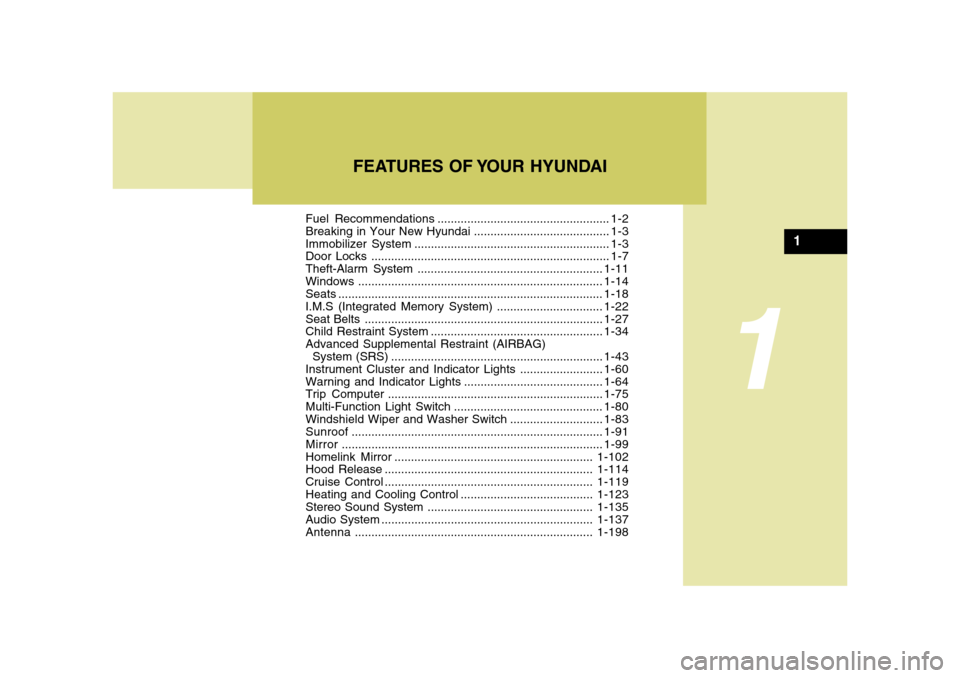
1
Fuel Recommendations.................................................... 1-2
Breaking in Your New Hyundai......................................... 1-3
Immobilizer System........................................................... 1-3
Door Locks ........................................................................ 1-7
Theft-Alarm System ........................................................1-11
Windows..........................................................................1-14
Seats................................................................................1-18
I.M.S (Integrated Memory System) ................................1-22
Seat Belts ........................................................................1-27
Child Restraint System ....................................................1-34
Advanced Supplemental Restraint (AIRBAG)
System (SRS) ................................................................1-43
Instrument Cluster and Indicator Lights .........................1-60
Warning and Indicator Lights..........................................1-64
Trip Computer .................................................................1-75
Multi-Function Light Switch .............................................1-80
Windshield Wiper and Washer Switch ............................1-83
Sunroof............................................................................1-91
Mirror...............................................................................1-99
Homelink Mirror ............................................................1-102
Hood Release ...............................................................1-114
Cruise Control...............................................................1-119
Heating and Cooling Control ........................................1-123
Stereo Sound System ..................................................1-135
Audio System................................................................1-137
Antenna ........................................................................1-198
FEATURES OF YOUR HYUNDAI
1
Page 21 of 345
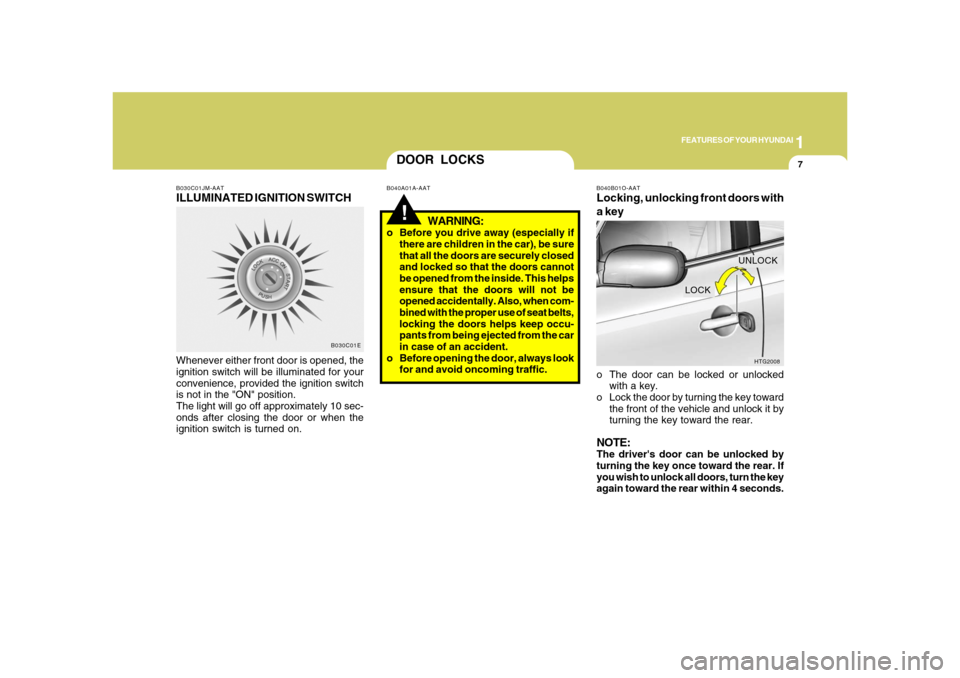
1
FEATURES OF YOUR HYUNDAI
7
B030C01JM-AATILLUMINATED IGNITION SWITCHWhenever either front door is opened, the
ignition switch will be illuminated for your
convenience, provided the ignition switch
is not in the "ON" position.
The light will go off approximately 10 sec-
onds after closing the door or when the
ignition switch is turned on.
B030C01E
DOOR LOCKS!
B040A01A-AAT
WARNING:
o Before you drive away (especially if
there are children in the car), be sure
that all the doors are securely closed
and locked so that the doors cannot
be opened from the inside. This helps
ensure that the doors will not be
opened accidentally. Also, when com-
bined with the proper use of seat belts,
locking the doors helps keep occu-
pants from being ejected from the car
in case of an accident.
o Before opening the door, always look
for and avoid oncoming traffic.
B040B01O-AATLocking, unlocking front doors with
a keyo The door can be locked or unlocked
with a key.
o Lock the door by turning the key toward
the front of the vehicle and unlock it by
turning the key toward the rear.NOTE:The driver's door can be unlocked by
turning the key once toward the rear. If
you wish to unlock all doors, turn the key
again toward the rear within 4 seconds.
HTG2008
LOCKUNLOCK
Page 23 of 345
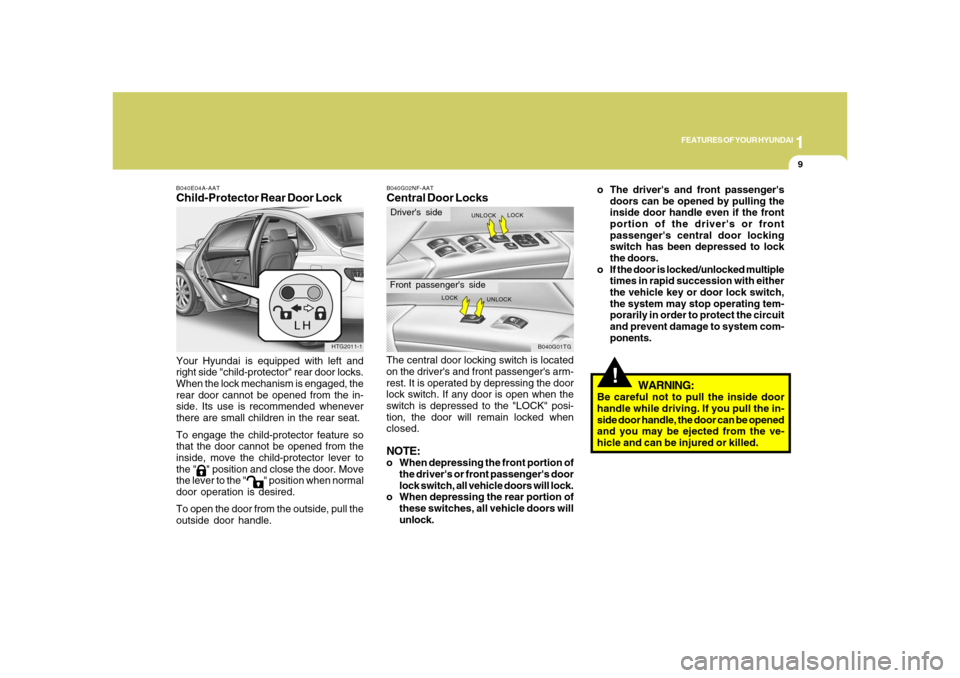
1
FEATURES OF YOUR HYUNDAI
9
B040E04A-AATChild-Protector Rear Door LockYour Hyundai is equipped with left and
right side "child-protector" rear door locks.
When the lock mechanism is engaged, the
rear door cannot be opened from the in-
side. Its use is recommended whenever
there are small children in the rear seat.
To engage the child-protector feature so
that the door cannot be opened from the
inside, move the child-protector lever to
the "
" position and close the door. Move
the lever to the "
" position when normal
door operation is desired.
To open the door from the outside, pull the
outside door handle.
HTG2011-1
B040G02NF-AATCentral Door LocksThe central door locking switch is located
on the driver's and front passenger's arm-
rest. It is operated by depressing the door
lock switch. If any door is open when the
switch is depressed to the "LOCK" posi-
tion, the door will remain locked when
closed.NOTE:o When depressing the front portion of
the driver's or front passenger's door
lock switch, all vehicle doors will lock.
o When depressing the rear portion of
these switches, all vehicle doors will
unlock.
B040G01TG
Driver's sideFront passenger's side
LOCK
UNLOCKLOCK
UNLOCK
!
WARNING:
Be careful not to pull the inside door
handle while driving. If you pull the in-
side door handle, the door can be opened
and you may be ejected from the ve-
hicle and can be injured or killed. o The driver's and front passenger's
doors can be opened by pulling the
inside door handle even if the front
portion of the driver's or front
passenger's central door locking
switch has been depressed to lock
the doors.
o If the door is locked/unlocked multiple
times in rapid succession with either
the vehicle key or door lock switch,
the system may stop operating tem-
porarily in order to protect the circuit
and prevent damage to system com-
ponents.
Page 38 of 345
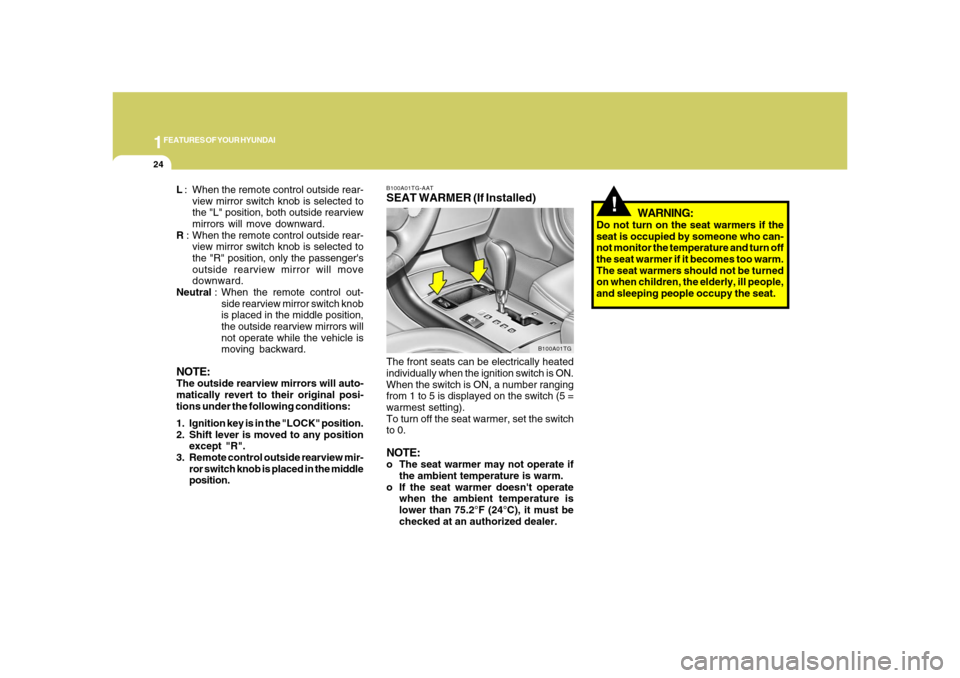
1FEATURES OF YOUR HYUNDAI24
!
B100A01TG-AATSEAT WARMER (If Installed)The front seats can be electrically heated
individually when the ignition switch is ON.
When the switch is ON, a number ranging
from 1 to 5 is displayed on the switch (5 =
warmest setting).
To turn off the seat warmer, set the switch
to 0.NOTE:o The seat warmer may not operate if
the ambient temperature is warm.
o If the seat warmer doesn't operate
when the ambient temperature is
lower than 75.2°F (24°C), it must be
checked at an authorized dealer.
B100A01TG
WARNING:
Do not turn on the seat warmers if the
seat is occupied by someone who can-
not monitor the temperature and turn off
the seat warmer if it becomes too warm.
The seat warmers should not be turned
on when children, the elderly, ill people,
and sleeping people occupy the seat. L : When the remote control outside rear-
view mirror switch knob is selected to
the "L" position, both outside rearview
mirrors will move downward.
R : When the remote control outside rear-
view mirror switch knob is selected to
the "R" position, only the passenger's
outside rearview mirror will move
downward.
Neutral : When the remote control out-
side rearview mirror switch knob
is placed in the middle position,
the outside rearview mirrors will
not operate while the vehicle is
moving backward.
NOTE:The outside rearview mirrors will auto-
matically revert to their original posi-
tions under the following conditions:
1. Ignition key is in the "LOCK" position.
2. Shift lever is moved to any position
except "R".
3. Remote control outside rearview mir-
ror switch knob is placed in the middle
position.
Page 41 of 345

1
FEATURES OF YOUR HYUNDAI
27
SEAT BELTS!
B150A02S-AATSEAT BELT PRECAUTIONS
WARNING:All occupants of the vehicle must wear
their seat belts at all times. Seat belts and
child restraints reduce the risk of serious
or fatal injuries for all occupants in the
event of a collision or sudden stop. With-
out a seat belt, occupants could be shifted
too close to a deploying airbag, strike the
interior structure or be thrown from the
vehicle. Properly worn seat belts greatly
reduce these hazards. Even with ad-
vanced airbags, unbelted occupants can
be severely injured by a deploying airbag.
Always follow the precautions about seat
belts, airbags and occupant safety con-
tained in this manual.B150B04Y-AATInfant or Small ChildAll 50 states have child restraint laws. You
should be aware of the specific require-
ments in your state. Child and/or infant
safety seats must be properly placed and
installed in the rear seat. Information about
the use of these restraints begins on page
1-34.
!
WARNING:
Every person in your vehicle needs to be
properly restrained at all times, includ-
ing infants and children. Never hold a
child in your arms or lap when riding in a
vehicle. The violent forces created dur-
ing a crash will tear the child from your
arms and throw the child against the
interior. Always use a child restraint
appropriate for your child's height and
weight, see page 1-34.NOTE:Small children are best protected from
injury in an accident when properly re-
strained in the rear seat by a child re-
straint system that meets the require-
ments of the Federal Motor Vehicle
Safety Standards. Before buying any
child restraint system, make sure that it
has a label certifying that it meets Fed-
eral Motor Vehicle Safety Standard 213.
The restraint must be appropriate for
your child's height and weight. Check
the label on the child restraint for this
information. See page 1-34.
B150C02A-AATLarger ChildrenChildren who are too large for child re-
straint systems should always occupy the
rear seat and use the available lap/shoul-
der belts. The lap portion should be fas-
tened snug on the hips and as low as
possible. Check belt fit periodically. A
child's squirming could put the belt out of
position. Children are afforded the most
safety in the event of an accident when
they are restrained by a proper restraint
system in the rear seat. If a larger child
(over age 13) must be seated in the front
seat, the child should be securely re-
strained by the available lap/shoulder belt
and the seat should be placed in the
rearmost position. Children under the age
of 13 should be restrained securely in the
rear seat. NEVER place a child under the
age of 13 in the front seat. NEVER place a
rear facing child seat in the front seat of a
vehicle.
Page 42 of 345
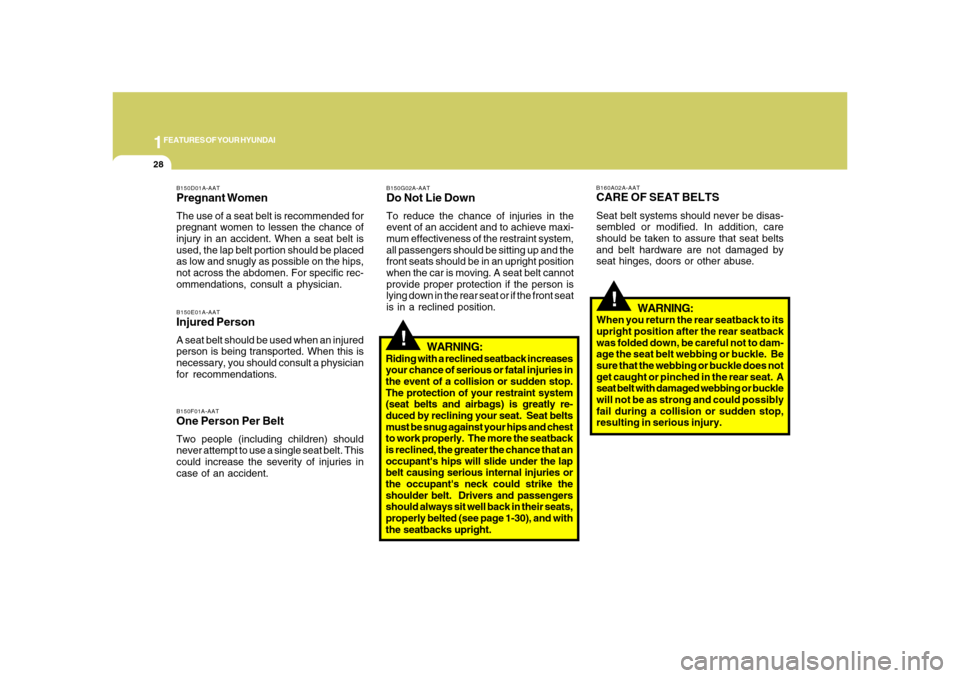
1FEATURES OF YOUR HYUNDAI28
!
B160A02A-AATCARE OF SEAT BELTSSeat belt systems should never be disas-
sembled or modified. In addition, care
should be taken to assure that seat belts
and belt hardware are not damaged by
seat hinges, doors or other abuse.
WARNING:
When you return the rear seatback to its
upright position after the rear seatback
was folded down, be careful not to dam-
age the seat belt webbing or buckle. Be
sure that the webbing or buckle does not
get caught or pinched in the rear seat. A
seat belt with damaged webbing or buckle
will not be as strong and could possibly
fail during a collision or sudden stop,
resulting in serious injury.
B150D01A-AATPregnant WomenThe use of a seat belt is recommended for
pregnant women to lessen the chance of
injury in an accident. When a seat belt is
used, the lap belt portion should be placed
as low and snugly as possible on the hips,
not across the abdomen. For specific rec-
ommendations, consult a physician.B150E01A-AATInjured PersonA seat belt should be used when an injured
person is being transported. When this is
necessary, you should consult a physician
for recommendations.B150F01A-AATOne Person Per BeltTwo people (including children) should
never attempt to use a single seat belt. This
could increase the severity of injuries in
case of an accident.
WARNING:
Riding with a reclined seatback increases
your chance of serious or fatal injuries in
the event of a collision or sudden stop.
The protection of your restraint system
(seat belts and airbags) is greatly re-
duced by reclining your seat. Seat belts
must be snug against your hips and chest
to work properly. The more the seatback
is reclined, the greater the chance that an
occupant's hips will slide under the lap
belt causing serious internal injuries or
the occupant's neck could strike the
shoulder belt. Drivers and passengers
should always sit well back in their seats,
properly belted (see page 1-30), and with
the seatbacks upright.
!
B150G02A-AATDo Not Lie DownTo reduce the chance of injuries in the
event of an accident and to achieve maxi-
mum effectiveness of the restraint system,
all passengers should be sitting up and the
front seats should be in an upright position
when the car is moving. A seat belt cannot
provide proper protection if the person is
lying down in the rear seat or if the front seat
is in a reclined position.
Page 44 of 345
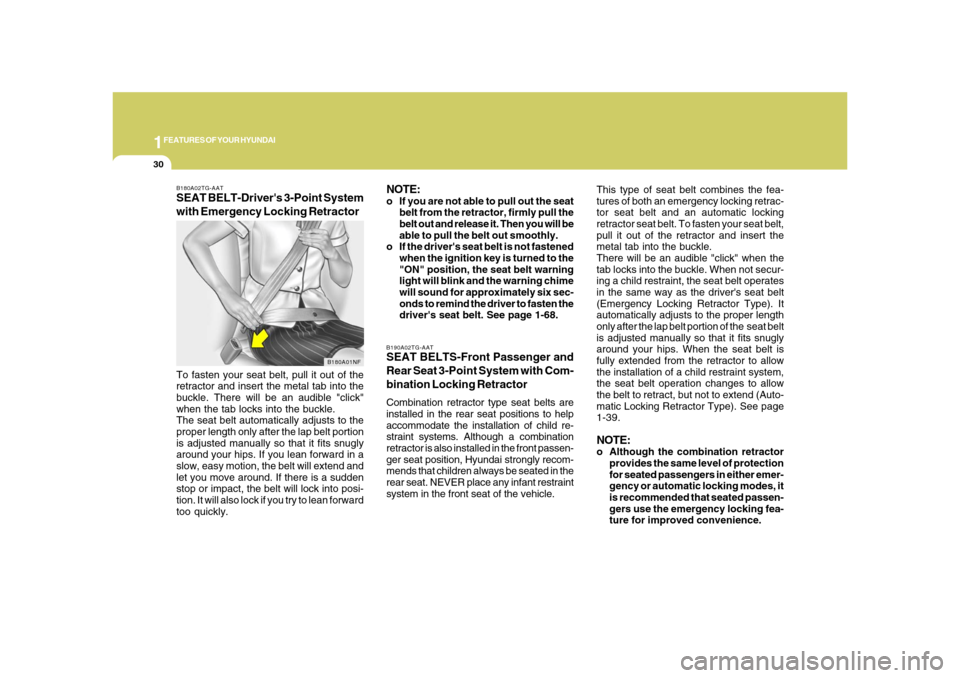
1FEATURES OF YOUR HYUNDAI30
This type of seat belt combines the fea-
tures of both an emergency locking retrac-
tor seat belt and an automatic locking
retractor seat belt. To fasten your seat belt,
pull it out of the retractor and insert the
metal tab into the buckle.
There will be an audible "click" when the
tab locks into the buckle. When not secur-
ing a child restraint, the seat belt operates
in the same way as the driver's seat belt
(Emergency Locking Retractor Type). It
automatically adjusts to the proper length
only after the lap belt portion of the seat belt
is adjusted manually so that it fits snugly
around your hips. When the seat belt is
fully extended from the retractor to allow
the installation of a child restraint system,
the seat belt operation changes to allow
the belt to retract, but not to extend (Auto-
matic Locking Retractor Type). See page
1-39.NOTE:o Although the combination retractor
provides the same level of protection
for seated passengers in either emer-
gency or automatic locking modes, it
is recommended that seated passen-
gers use the emergency locking fea-
ture for improved convenience.
B190A02TG-AATSEAT BELTS-Front Passenger and
Rear Seat 3-Point System with Com-
bination Locking RetractorCombination retractor type seat belts are
installed in the rear seat positions to help
accommodate the installation of child re-
straint systems. Although a combination
retractor is also installed in the front passen-
ger seat position, Hyundai strongly recom-
mends that children always be seated in the
rear seat. NEVER place any infant restraint
system in the front seat of the vehicle.
B180A02TG-AATSEAT BELT-Driver's 3-Point System
with Emergency Locking RetractorTo fasten your seat belt, pull it out of the
retractor and insert the metal tab into the
buckle. There will be an audible "click"
when the tab locks into the buckle.
The seat belt automatically adjusts to the
proper length only after the lap belt portion
is adjusted manually so that it fits snugly
around your hips. If you lean forward in a
slow, easy motion, the belt will extend and
let you move around. If there is a sudden
stop or impact, the belt will lock into posi-
tion. It will also lock if you try to lean forward
too quickly.
B180A01NF
NOTE:o If you are not able to pull out the seat
belt from the retractor, firmly pull the
belt out and release it. Then you will be
able to pull the belt out smoothly.
o If the driver's seat belt is not fastened
when the ignition key is turned to the
"ON" position, the seat belt warning
light will blink and the warning chime
will sound for approximately six sec-
onds to remind the driver to fasten the
driver's seat belt. See page 1-68.
Page 45 of 345
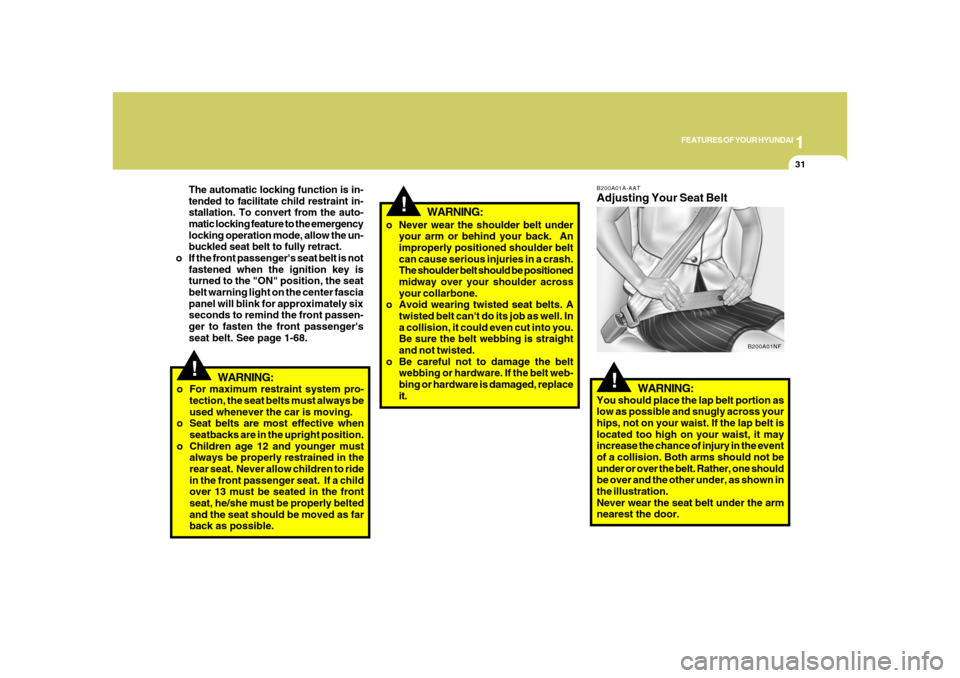
1
FEATURES OF YOUR HYUNDAI
31
!
WARNING:
o For maximum restraint system pro-
tection, the seat belts must always be
used whenever the car is moving.
o Seat belts are most effective when
seatbacks are in the upright position.
o Children age 12 and younger must
always be properly restrained in the
rear seat. Never allow children to ride
in the front passenger seat. If a child
over 13 must be seated in the front
seat, he/she must be properly belted
and the seat should be moved as far
back as possible.
!The automatic locking function is in-
tended to facilitate child restraint in-
stallation. To convert from the auto-
matic locking feature to the emergency
locking operation mode, allow the un-
buckled seat belt to fully retract.
o If the front passenger's seat belt is not
fastened when the ignition key is
turned to the "ON" position, the seat
belt warning light on the center fascia
panel will blink for approximately six
seconds to remind the front passen-
ger to fasten the front passenger's
seat belt. See page 1-68.o Never wear the shoulder belt under
your arm or behind your back. An
improperly positioned shoulder belt
can cause serious injuries in a crash.
The shoulder belt should be positioned
midway over your shoulder across
your collarbone.
o Avoid wearing twisted seat belts. A
twisted belt can't do its job as well. In
a collision, it could even cut into you.
Be sure the belt webbing is straight
and not twisted.
o Be careful not to damage the belt
webbing or hardware. If the belt web-
bing or hardware is damaged, replace
it.
WARNING:
WARNING:
You should place the lap belt portion as
low as possible and snugly across your
hips, not on your waist. If the lap belt is
located too high on your waist, it may
increase the chance of injury in the event
of a collision. Both arms should not be
under or over the belt. Rather, one should
be over and the other under, as shown in
the illustration.
Never wear the seat belt under the arm
nearest the door.
!
B200A01A-AATAdjusting Your Seat Belt
B200A01NF
Page 48 of 345
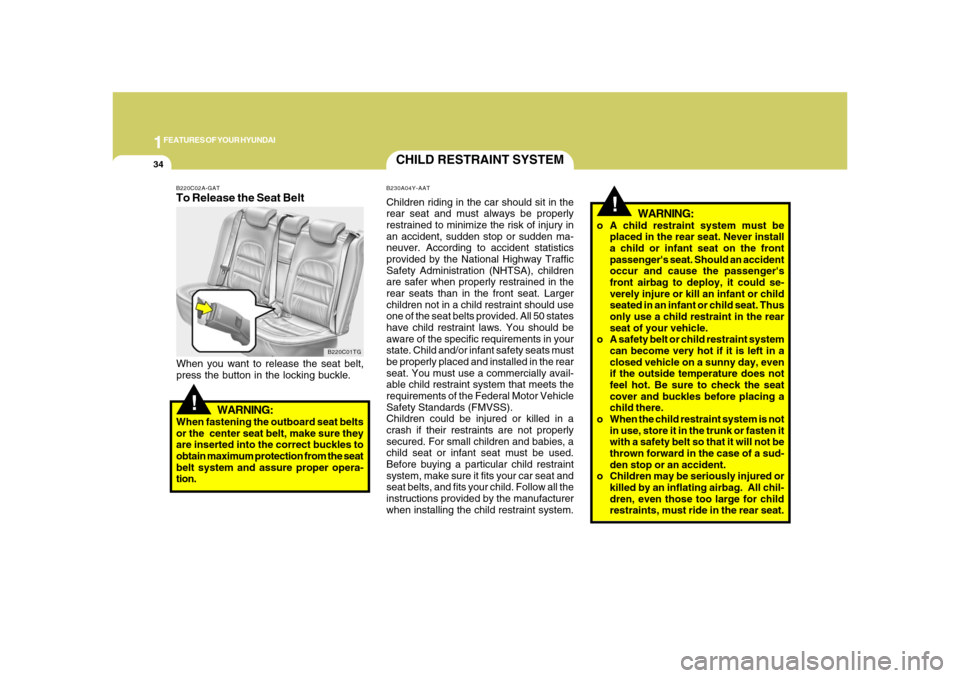
1FEATURES OF YOUR HYUNDAI34
!
WARNING:
o A child restraint system must be
placed in the rear seat. Never install
a child or infant seat on the front
passenger's seat. Should an accident
occur and cause the passenger's
front airbag to deploy, it could se-
verely injure or kill an infant or child
seated in an infant or child seat. Thus
only use a child restraint in the rear
seat of your vehicle.
o A safety belt or child restraint system
can become very hot if it is left in a
closed vehicle on a sunny day, even
if the outside temperature does not
feel hot. Be sure to check the seat
cover and buckles before placing a
child there.
o When the child restraint system is not
in use, store it in the trunk or fasten it
with a safety belt so that it will not be
thrown forward in the case of a sud-
den stop or an accident.
o Children may be seriously injured or
killed by an inflating airbag. All chil-
dren, even those too large for child
restraints, must ride in the rear seat.
B220C02A-GATTo Release the Seat BeltWhen you want to release the seat belt,
press the button in the locking buckle.
!
WARNING:
When fastening the outboard seat belts
or the center seat belt, make sure they
are inserted into the correct buckles to
obtain maximum protection from the seat
belt system and assure proper opera-
tion.
CHILD RESTRAINT SYSTEMB230A04Y-AATChildren riding in the car should sit in the
rear seat and must always be properly
restrained to minimize the risk of injury in
an accident, sudden stop or sudden ma-
neuver. According to accident statistics
provided by the National Highway Traffic
Safety Administration (NHTSA), children
are safer when properly restrained in the
rear seats than in the front seat. Larger
children not in a child restraint should use
one of the seat belts provided. All 50 states
have child restraint laws. You should be
aware of the specific requirements in your
state. Child and/or infant safety seats must
be properly placed and installed in the rear
seat. You must use a commercially avail-
able child restraint system that meets the
requirements of the Federal Motor Vehicle
Safety Standards (FMVSS).
Children could be injured or killed in a
crash if their restraints are not properly
secured. For small children and babies, a
child seat or infant seat must be used.
Before buying a particular child restraint
system, make sure it fits your car seat and
seat belts, and fits your child. Follow all the
instructions provided by the manufacturer
when installing the child restraint system.
B220C01TG
Page 49 of 345
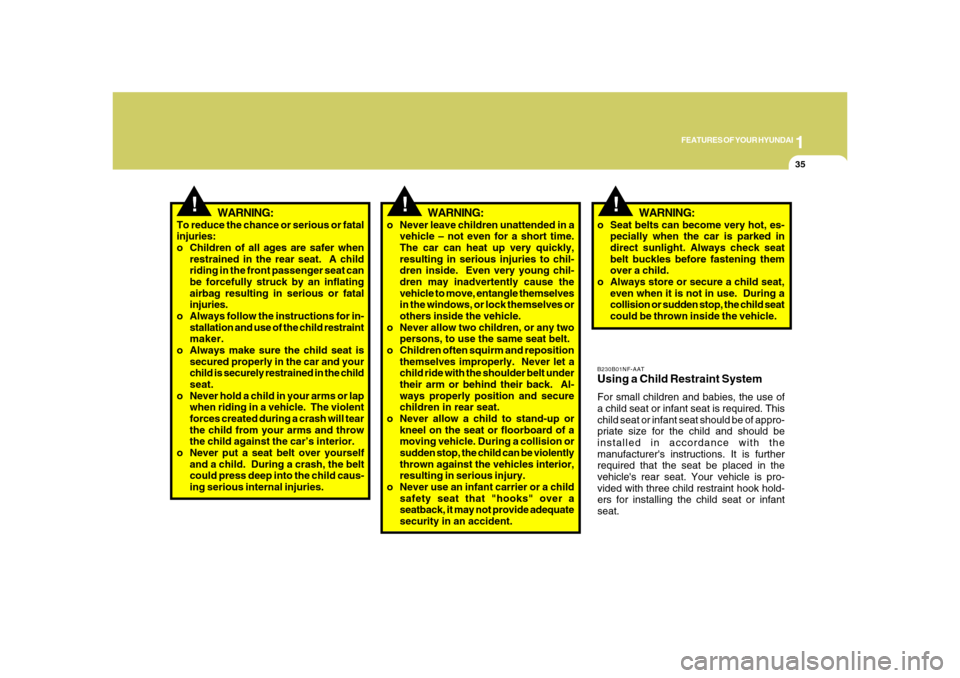
1
FEATURES OF YOUR HYUNDAI
35
!
To reduce the chance or serious or fatal
injuries:
o Children of all ages are safer when
restrained in the rear seat. A child
riding in the front passenger seat can
be forcefully struck by an inflating
airbag resulting in serious or fatal
injuries.
o Always follow the instructions for in-
stallation and use of the child restraint
maker.
o Always make sure the child seat is
secured properly in the car and your
child is securely restrained in the child
seat.
o Never hold a child in your arms or lap
when riding in a vehicle. The violent
forces created during a crash will tear
the child from your arms and throw
the child against the car’s interior.
o Never put a seat belt over yourself
and a child. During a crash, the belt
could press deep into the child caus-
ing serious internal injuries.o Never leave children unattended in a
vehicle – not even for a short time.
The car can heat up very quickly,
resulting in serious injuries to chil-
dren inside. Even very young chil-
dren may inadvertently cause the
vehicle to move, entangle themselves
in the windows, or lock themselves or
others inside the vehicle.
o Never allow two children, or any two
persons, to use the same seat belt.
o Children often squirm and reposition
themselves improperly. Never let a
child ride with the shoulder belt under
their arm or behind their back. Al-
ways properly position and secure
children in rear seat.
o Never allow a child to stand-up or
kneel on the seat or floorboard of a
moving vehicle. During a collision or
sudden stop, the child can be violently
thrown against the vehicles interior,
resulting in serious injury.
o Never use an infant carrier or a child
safety seat that "hooks" over a
seatback, it may not provide adequate
security in an accident.
!
WARNING: WARNING:
!
WARNING:
B230B01NF-AATUsing a Child Restraint SystemFor small children and babies, the use of
a child seat or infant seat is required. This
child seat or infant seat should be of appro-
priate size for the child and should be
installed in accordance with the
manufacturer's instructions. It is further
required that the seat be placed in the
vehicle's rear seat. Your vehicle is pro-
vided with three child restraint hook hold-
ers for installing the child seat or infant
seat. o Seat belts can become very hot, es-
pecially when the car is parked in
direct sunlight. Always check seat
belt buckles before fastening them
over a child.
o Always store or secure a child seat,
even when it is not in use. During a
collision or sudden stop, the child seat
could be thrown inside the vehicle.